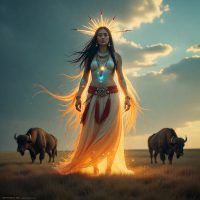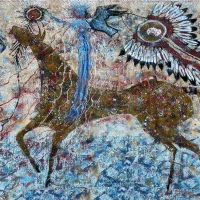Wakan Tanka : The Sacred Creator Force in Lakota Cosmology
Listen
At a glance
| Description | |
|---|---|
| Origin | Lakota Mythology |
| Classification | Gods |
| Family Members | N/A |
| Region | United States of America |
| Associated With | Creation |
Wakan Tanka
Introduction
Wakan Tanka is the foundational spiritual force at the heart of Lakota cosmology, representing the sacred origin and cohesive power of all existence. In the Lakota language, the term Wakȟáŋ Tȟáŋka translates to “Great Mystery,” a phrase that emphasizes its role not as a single anthropomorphic deity but as a profound, all-encompassing sacred presence. For the Lakota, spirituality is deeply relational, rooted in the understanding that everything in the universe—humans, animals, plants, elements, and unseen spirits—shares the same divine essence. Wakan Tanka is the source of that interconnectedness, the creative power that brought forth the universe and remains woven into every part of the natural world. This concept forms the bedrock of Lakota thought, shaping how people approach creation, morality, community, and the environment.
Physical Traits
Wakan Tanka is not depicted with human features, and its nature intentionally avoids all physical representation. Unlike many world mythologies where gods are assigned bodies, faces, or genders, the Lakota perceive Wakan Tanka as a formless spiritual essence. Its existence is recognized not through imagery but through presence—felt in sunlight, heard in wind, seen in the movement of the buffalo, and experienced through sacred ceremonies. Natural elements such as the sun (Wi), earth (Maka), sky (Skan), and stone (Inyan) reflect specific aspects of Wakan Tanka, not by acting as separate gods but as expressions of the same sacred mystery. The absence of a physical form underscores the Lakota belief that the divine cannot be confined to any single shape, and that all of nature is a living manifestation of Wakan Tanka’s power.
Family
Rather than functioning as a deity with a conventional family lineage, Wakan Tanka embodies a collective unity of spiritual beings that work together to shape and sustain creation. In Lakota tradition, the earliest sacred beings—Inyan, Maka, Skan, and Wi—emerged from Wakan Tanka’s creative energy, each representing an essential aspect of existence. These entities are not literal offspring but emanations of the same sacred source, reflecting how the Lakota view creation as an unfolding of interconnected powers rather than a genealogical hierarchy. This worldview is echoed in the guiding principle Mitákuye Oyás’iŋ (“all my relations”), which expresses the belief that everything in the universe—people, animals, spirits, and natural elements—forms an extended sacred family with Wakan Tanka at its center.
Other names
Although “Wakan Tanka” is the most widely used name, several translations and related terms have appeared across Lakota and broader Siouan cultures. The English phrase “Great Spirit” was introduced by missionaries and early anthropologists, but many Lakota elders argue that “Great Mystery” is a truer reflection of the concept’s spiritual depth. Variations such as Wakanda or Wakonda appear in related Siouan tribes, illustrating linguistic connections across Indigenous nations. Individual aspects of Wakan Tanka also carry their own names—Wi for the Sun, Hanwi for the Moon, and Inyan for Stone—yet all remain tied to the central sacred force. These names highlight how Wakan Tanka is understood not as a single entity with multiple titles but as a living mystery too vast to be encapsulated by one term alone.
Powers and Abilities
Wakan Tanka is the origin of creation and the spiritual power that sustains all life. Its abilities encompass the formation of the universe, the ongoing balance of natural forces, and the spiritual guidance provided to those who walk the Lakota path. As the source of sacred energy, Wakan Tanka governs the cycles of the seasons, the growth of plants, the health of animals, and the harmony of communities. Its influence is invoked during pivotal ceremonies such as the Sun Dance, sweat lodge purification, and vision quests, where participants seek healing, clarity, and direction. Wakan Tanka’s power does not operate through divine punishment or reward; instead, it functions through balance, teaching humans to live with humility, respect, and reciprocity. Medicine people and spiritual leaders interpret dreams, visions, and signs believed to come from Wakan Tanka, reinforcing its role as a guiding and restorative force.
Modern Day Influence
Today, Wakan Tanka remains central to the cultural resilience and spiritual identity of the Lakota people. Despite historical suppression of Indigenous religions, ceremonies honoring Wakan Tanka have seen a powerful revival, supported by language revitalization efforts, cultural preservation programs, and Indigenous-led spiritual movements. The concept of Wakan Tanka also resonates in contemporary conversations about environmental protection, where Indigenous worldviews rooted in kinship and ecological balance offer vital perspectives. Activists, scholars, and artists draw upon Wakan Tanka as a symbol of sovereignty, community, and healing, demonstrating its enduring relevance in modern struggles for land rights and cultural recognition. Beyond Indigenous communities, Wakan Tanka has attracted widespread interest, though Lakota leaders stress the need for respectful engagement that avoids cultural appropriation. When acknowledged in its proper context, the Great Mystery offers a profound alternative worldview centered on unity, humility, and sacred responsibility to all life.
Related Images
Source
Benton-Banai, E. (1988). The Mishomis Book: The Voice of the Ojibway. University of Minnesota Press.
Powers, W. K. (1986). Oglala Religion. University of Nebraska Press.
Walker, J. R. (1982). Lakota Belief and Ritual. University of Nebraska Press.
DeMallie, R. J. (1984). The Sixth Grandfather: Black Elk’s Teachings Given to John G. Neihardt. University of Nebraska Press.
“Wakan Tanka.” UXL Encyclopedia of World Mythology. Encyclopedia.com. https://www.encyclopedia.com/humanities/news-wires-white-papers-and-books/wakan-tanka
Wakan Tanka: Supreme Being in Lakota Mythology.” Avid-Archer.com. https://avid-archer.com/wakan-tanka-supreme-being-in-lakota-mythology/
“Great Spirit – Wikipedia.” https://en.wikipedia.org/wiki/Great_Spirit
Frequently Asked Questions
What does Wakan Tanka mean in Lakota spirituality?
Wakan Tanka means “Great Mystery,” referring to the sacred creative force that exists in all things within Lakota belief.
Is Wakan Tanka the same as the Great Spirit?
While often translated as “Great Spirit,” many Lakota prefer “Great Mystery” because it better reflects its complex and non-anthropomorphic nature.
Does Wakan Tanka have a physical form?
No. Wakan Tanka is a formless sacred power expressed through nature rather than a deity with human traits.
How is Wakan Tanka worshipped today?
It is honored through ceremonies such as the Sun Dance, sweat lodge rituals, prayer offerings, and cultural practices passed through Lakota traditions.
Is Wakan Tanka a single god or many gods?
Wakan Tanka is a unified sacred force expressed through multiple aspects, not a pantheon of separate gods.







